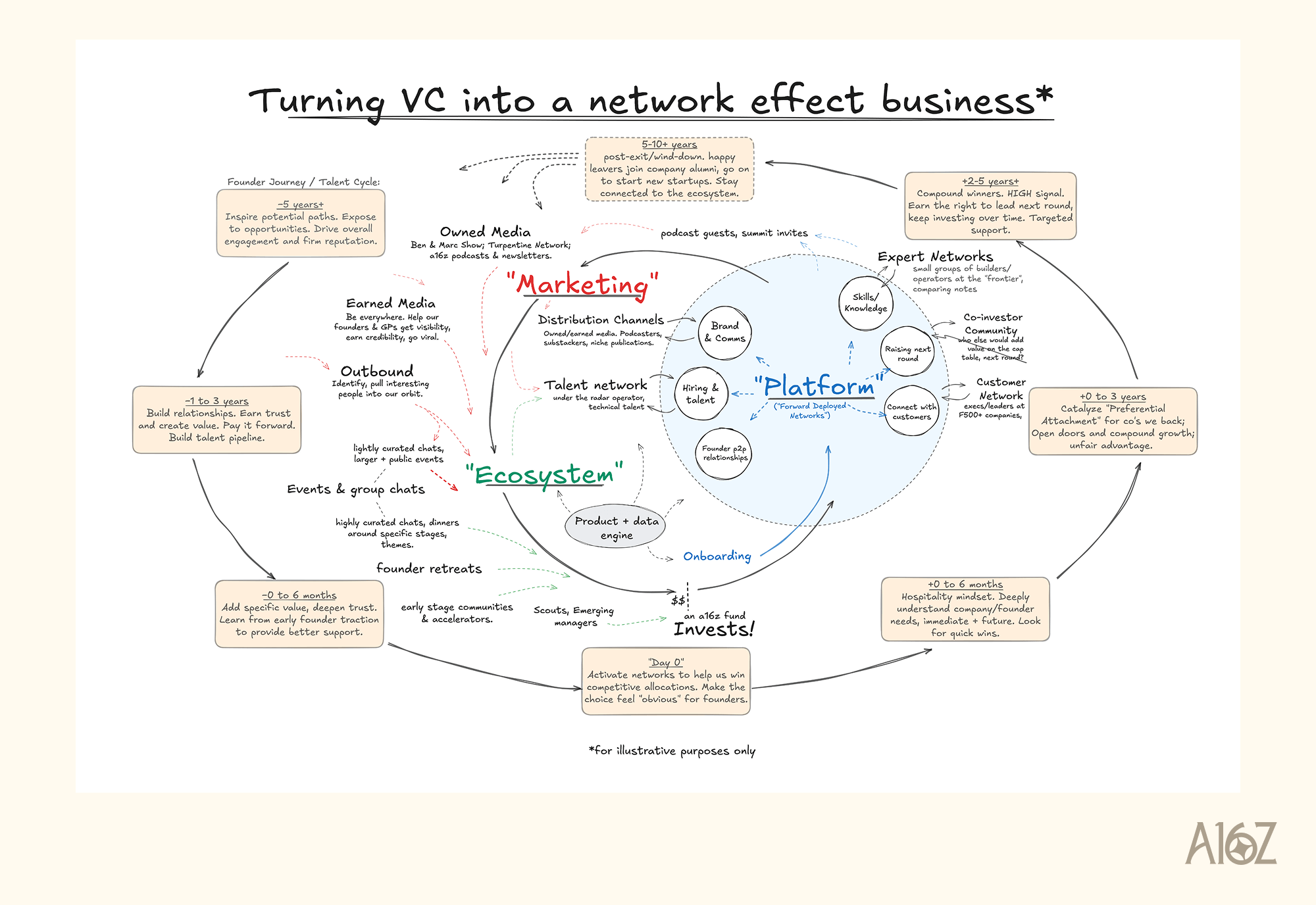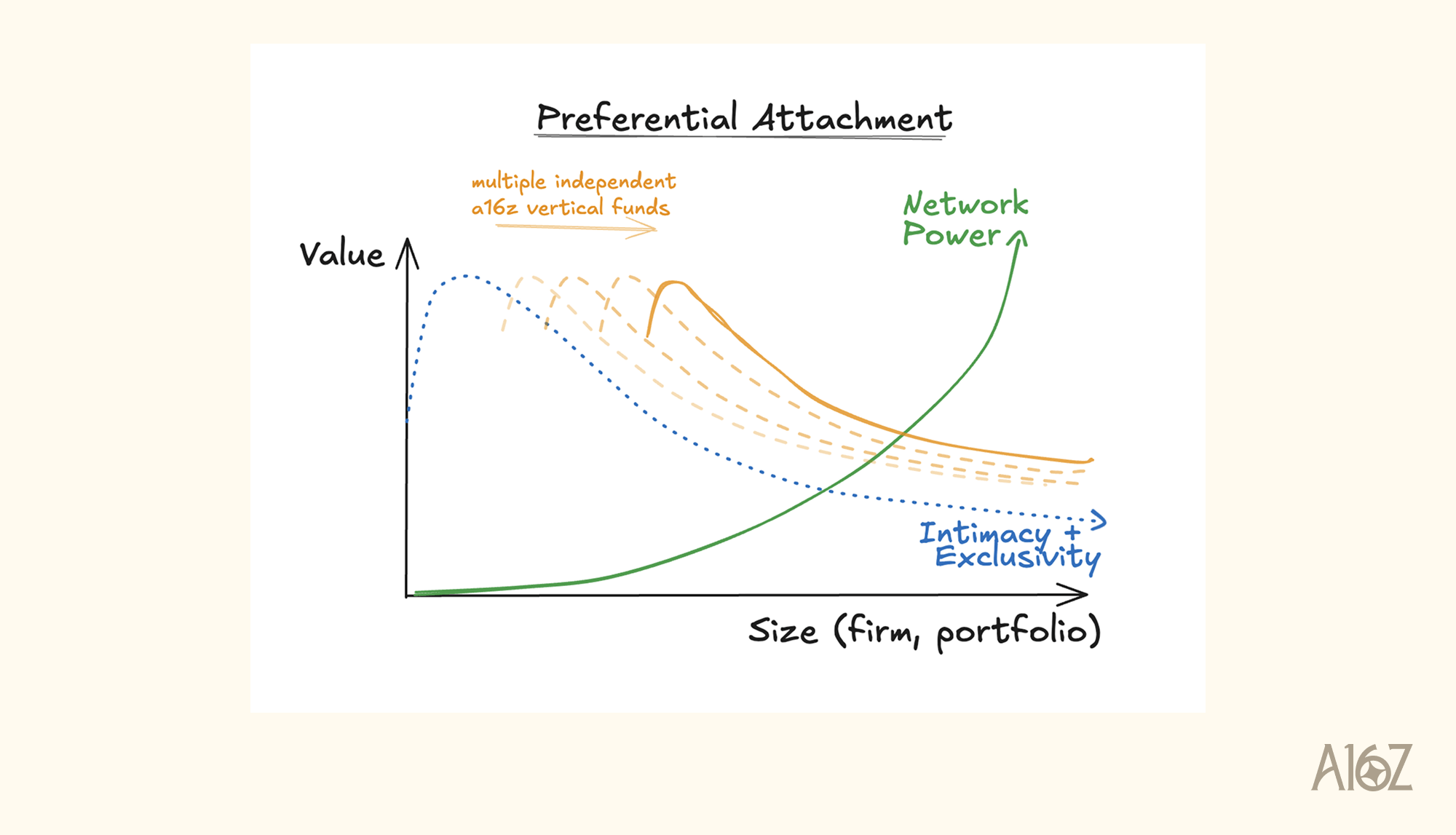Some news… I’ve joined a16z!
After two years at Blackbird in New Zealand, I’m headed back to the Bay Area.
I’m joining a16z as Partner and Head of Ecosystem. Teaming up with Erik Torenberg again to continue what has become my life’s work: responsible for expanding and reinforcing the multitude of networks spanning across our firm, building a constellation of communities, pipelines for emerging talent, customer networks, products and experiences that help founders, operators and investors connect and build together.
Preferential Attachment is what makes startups workHere’s Marc, with John Collision and Charlie Songhurst on “Cheeky Pint”:
“…a startup needs to get into a loop where it’s accruing more and more resources as it goes… qualified executives, technical employees, future downstream financing, positive brand momentum, public perception, customers, revenue, ability to throw weight in the government… you’re either a snowball rolling down the hill, picking up resources, gaining size and scope and scale, power, credibility as you go, or you’re not – you’re kinda stuck at the top of the hill as a snowflake and you’re just not going anywhere. …the question becomes how do you get [this process] started… to the point where the next resource that you need is more likely to attach to your thing as opposed to somebody else. That’s the mechanical process that drives the power law. Economists call it preferential attachment.
Startups win when everything in their world starts to preferentially attach to them. That attachment doesn’t always come naturally… when a company is early in its life, or when a person is early in their career, there’s a trust and credibility hurdle that must be overcome each time. Friends, allies, and co-signers can help catalyze that attachment, by staking some of their reputation and/or capital, for example a young person with no assets trying to buy a house might ask a trusted friend, family or community member to “co-sign” their mortgage.
Raising from a top-tier VC has always been a way to accelerate this. As Marc continues…
…a top-tier VC is a bridge loan of credibility at a point in time where a startup deserves credibility but doesn’t have it yet. This is then harvested in the form of personnel, customers, brand.”
More and more we see that the Series A and/or B round lead (or absence thereof) is the strongest leading indicator of the ultimate outcome.
One bet I’m willing to take is that as everything around us becomes “technology”, and earlier stage VC continues to institutionalize – this will only become more true.
VC has traditionally done “preferential attachment” non-scalably.Venture capital firms win through building personal trust, hands-on partnership between GPs and their founders. GP “value add” comes via their ability to allocate personal time and attention, make introductions into their personal network, maintain a sense of intimacy with the company and the challenges it’s trying to overcome. This has always been the job of the VC, some do it better than others.
But intimacy doesn’t scale. Each new investment divides partner attention further. You can add headcount, platform functions, but traditional ‘services’ approaches hit diminishing returns to scale. Moreover, it doesn’t help you with all of the follow-on preferential attachment that has to relentlessly compound in the snowball’s trip down the hill; nearly as much as you’d like. Venture can feel like the opposite of a network-effect business: the bigger the portfolio, the more dilute your attention, and the weaker VC’s incremental value-add on helping any particular snowflake attach to the snowball.
But does it need to be that way?
For years I’ve been obsessed with this idea of “turning VC into a network effect business.”
One of my early career inflection points was AngelList in 2014, where I first saw how software could turn networks into infrastructure—removing friction from company formation, capital raising, hiring, and distribution. This became a thread that would weave throughout my subsequent decade and ultimately led to my teaming up with Erik the first time around—fresh out of a similar formative experience at Product Hunt.
The insight: VC firms need to think like networked product builders, not just service providers. Instead of dividing partner attention across n+1 companies, you build systems where value compounds—where founders connect to other founders, operators access expertise across the portfolio, and every talented individual who joins becomes another n^2 on the network’s value to each participant.
This is what unlocks scalable preferential attachment. A strong brand signals credibility. A large network provides resources. But each on its own is not enough. The combination—a brand that attracts top talent into a network that makes them more successful—creates the compounding loop that drives power law outcomes. Every new founder who joins strengthens the signal for the next one. Every successful exit produces the next generation of operators, angels, and advisors who stay in orbit.

The result: a switch from diminishing returns to compounding value. Intimacy and direct relationships with GPs remain foundational, but those GPs now have a very long lever with which to help founders move the world, and can focus their time/attention on the really critical decisions that founders are facing.
a16z is one among very few who have managed to cross this chasm—delivering intimacy and exclusivity on the front end (direct relationships between vertical fund GPs and founders), AND network effects on the back. Operating a platform that institutionalizes access to resources and talent, at a scale few yet understand.
Be the F1 pit crew of venture.Big VC is like Formula 1.
Hyper-competitive. Big budgets. Media & brand-driven. Top teams need to win hearts and minds, as well as races.
GPs are the drivers—highly attuned to the conditions on the road, what lies around the next bend. The greats become household names and go on generational winning streaks: Lewis Hamilton, Michael Schumacher… Don Valentine, Marc Andreessen.
But when Hamilton stands on the F1 podium, it’s easy to miss the work that went on behind the scenes to get him there. Races are won or lost years in advance by teams who design the right chassis, hire the right engineers, drill their pit crews, build cult-like fanbases to keep the sponsor dollars flowing.
VC is the same: the GP has to win the deal, it’s easy to glamorize the GP standing by the founder, ringing the NYSE bell — but at the best firms there’s an invisible engine behind them, a “Pit Crew” that must execute immediately and flawlessly, every time.
Adrian Newey didn’t win any races — but his arrival as CTO at Red Bull transformed them from a cash-burning midfield team into a generational, world-champion franchise. And the generational VC firms of the next decade won’t just have the best drivers; they’ll also make the biggest investment in the machines they sit in.
I believe we can turn a16z into the most effective, scalable preferential attachment machine in the world by taking a “network view” to the ecosystem we operate within.
If “marketing” is the top-down vector of storytelling, “ecosystem” is the bottom-up vector of trust. While marketing expands brand and visibility, helps shape the conversation; ecosystem creates the rooms and networks in which those conversations take place.
Ecosystem is the hidden operating system of venture. It’s understanding that today’s senior product manager is tomorrow’s founder; today’s founder becomes tomorrow’s angel investor or advisor; and building the infrastructure to support those 5-10 year journeys as they play out. It’s what made firms like YC, First Round so powerful.
When done right, it’s measurable in deal quality, founder retention, talent density, and the gravitational pull of the firm. When done poorly, it’s a disconnected collection of events, with no moat beyond the individual partner personalities.
When the two are in sync, you get the compounding engine that made Silicon Valley what it is: a dense network of people who believe in the same future—and are willing to build it together.
I’m stoked to come back to SF and make it happen. LFG
</div>

